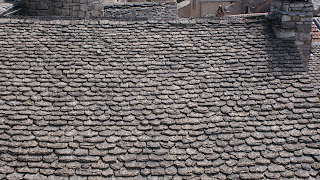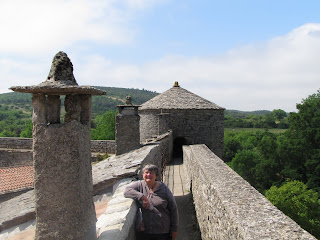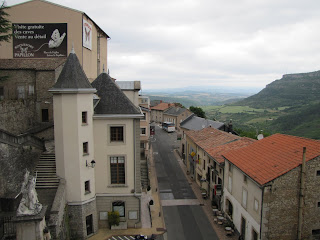La Couvertoirade (pronounced coo-ver-twa-rod, a word we stumble over almost every time we say it) is a small, intact walled city built by the Knights Templar and Knights Hospitaliers in the 11th century.


It seems quite undiscovered by tourists (although there are lots of parking spaces available, so summer could be bad). It's purpose was to protect its citizens and pilgrims to Saint Compostelle from medieval "routiers" (bandits who preyed on the unprotected) and to keep epidemics out of the town.
We learn a lot about the Knights Templar and Hospitalier at this site as the town owes it's existence to them. These knights were monks turned knights at the request of the Pope to protect the Holy Land of Jerusalem and the pilgrims it attracted. They were given money, lands, and power through the Pope and were quite popular while the Holy Land was in the hands of the crusaders. The Templars fought the infidel whenever Christians were threatened in Jerusalem and the Hospitaliers provided aid and comfort to travelers, those injured and those needing housing or other aid. It seems a bit incongruous to us that monks were also murderers, but that seems to be the case. As well, their development into many "commanderies" in France and elsewhere provided them with lands and resources to create wealth, which became considerable.
 (Clark photo of his t-shirt souvenir)
(Clark photo of his t-shirt souvenir)When the Holy Lands were lost, the Templars returned to France to their commanderies. When not crusaders, they were regular monks who worked the lands, following their vows of poverty, purity and piety. At some point the Templars became so rich that King Philip IV considered them a threat to his power (it didn't help that the King owed a lot of money to the Templars). So Philip had many arrested, tortured and killed. He later convinced the Pope to disband the order. The Templar wealth was given to the Hospitaliers. (We're not sure why they weren't a threat too). The Hospitaliers exist today as the Knights of Malta and continue to do their "hospitality" work from the Vatican.
Couvertoirade was part of one such Templar commanderie. Before the Templars arrived there was only a small village and a church. The Templars built a walled castle finished in 1249 on the site and the villagers then crowded their houses up against the castle, presumably to take advantage of the castle's safety in times of lawlessness. This Templar outpost grew corn, raised horses for the crusades, and raised sheep for their many products in support of the Crusades. During the 100 years war the Prior of the Commandery had a wall built around the houses to further protect the village. The wall now encloses the small village of stone buildings and with the exception of the south gate are intact.

Within the defensive walls, the houses have slate roofs which collect rainwater into cisterns under the houses. Access to water on the top of the Causse is a problem and so every drop of rain needs to be captured.
 (Clark photo)
(Clark photo) (Clark photo)
(Clark photo)Houses were built to shelter animals on the street level with the family living above and fodder stored under the attic roof serving both as storage and insulation.


Sheep herding was the main occupation and there was a large pond inside the town at one time (it's now an open square) for watering the flocks. Another is built outside the town walls.
We purchase tickets to see the ramparts

and for use of an audio guide which turns out to be very well done and very informative.

(However, we must return the audio guide after 2 PM when the tourist bureau opens again for the afternoon. This is no problem as we plan to eat our picnic lunch here anyway.)
Our guide leads us on a visit of the castle (closed except in Jul and Aug),
 (Clark photo)
(Clark photo)the church and grave yard,

 (Clark photo)
(Clark photo)the community bake ovens (where they are making delicious pizzas today),

the two 17th century town homes, the mill (on the hill outside town),
 (Janis photo)
(Janis photo)and along the few streets. There are artisanal shops selling leather, foods, clothing, and linens as well as a couple souvenir shops. A few cafés offer lunch and coffee.
We eat our lunch on a bench outside the north gate of the town, finish our tour and then head off across the Causse Larzac to Roquefort.
As much as La Couvertoirade was a delightful surprise and discovery, Roquefort is a disappointment. The hour-long drive has been lovely, the town clings picturesquely to the side of the hill where the maturation caves are, but the tour of the Société caves is disappointing to say the least.


We arrive in time for the last tour which has more than 30 people on it. The tour is only in French, although we are given a printed English explanation which we cannot read in the darkness of the tour route. It costs 5 Euros each. We only have to wait 5 minutes to start. We climb up and down stairs through dark-walled corridors inside the cave. The guide speaks fast and not clearly, I have to work hard to understand the gist of what she is saying and I'm not much help translating for Dave and Janis and Clark. There is little to see and lots to hear. We start with an interactive diorama showing how the mountains fall down revealing the caves during the Quartenary era. Lame. Then we see a film, supposedly to learn how they make the cheese. There's no language at all, just images, which is good, but there's also little to be learned about how this whole process works. The ewes are milked, it's shipped to be made to cheese, penicillin is added to make the blue lines of the cheese and then it's stored in caves to mature and checked by someone who takes out a plug and smells it. Also lame.
Then we walk through the fleurines (cracks in the rock that allow fresh air to move. We learn there's really nothing to see here. The cheese is made in other factories and then transported here to age in the caves. So there are rows and rows of shelving where the cheeses are set out for 3 months until the penicillin creates the appropriate level of blue veining. This is watched over by a man whose job is to check the cheeses each day and determine when they are ripe. Once ripe, the cheeses are wrapped in foil and then moved to climate controlled storage (a refrigerator) until shipped. And it turns out the cheese-making is seasonal and there won't be cheeses here to ripen until July when the next season of cheese-making happens. What a bust.
And then to end the trip, we pass through the "tasting" room where the 3 types of Société Roquefort cheeses are out on plates and you can taste them with toothpicks to pick up the chunks as you wind your way around the counter to where you can purchase the Roquefort variety and size of your choice.
We buy the smallest package that contains the 3 different types and leave, greatly disappointed that we wasted 5 Euros each on this bust of a tour.
Once home, we have aperos, a wonderful salad made by Janis with the perfectly ripe pears, goat cheese and pistachios. We followed that with Wienerschnitzel by special request from David. And we had our first patisserie purchased dessert, éclairs from the bakery along with Cartagène, the fortified wine we bought at St Chinian. Life is good.
Bummer about Roquefort, it had such positive potential.
ReplyDelete